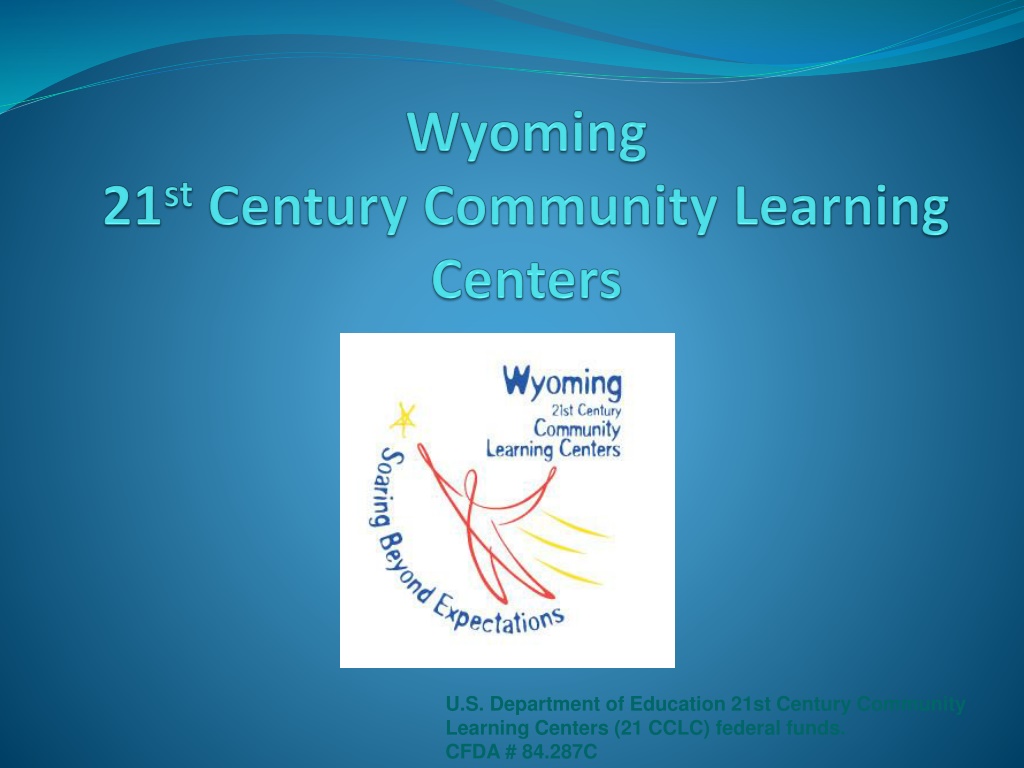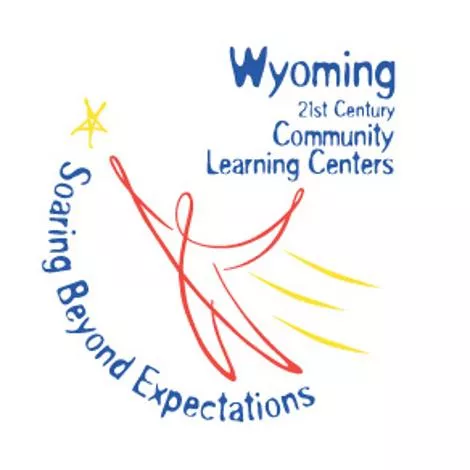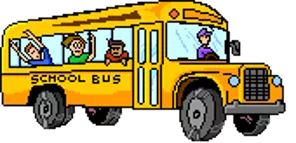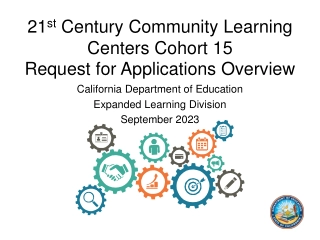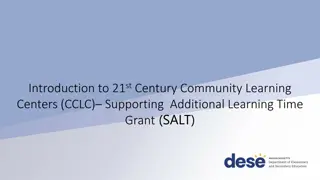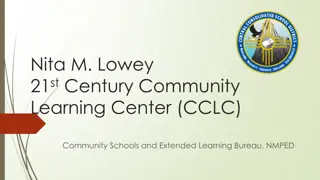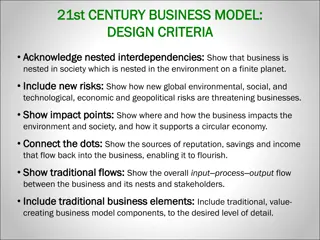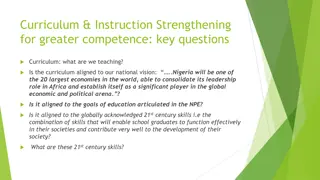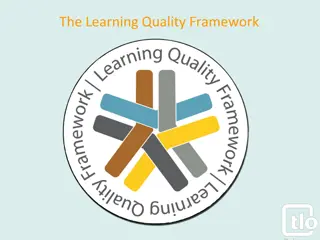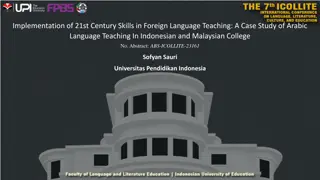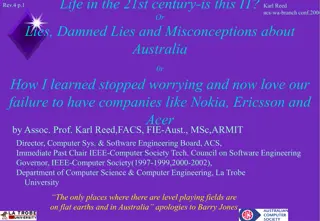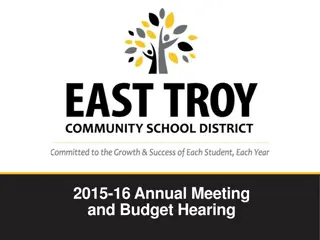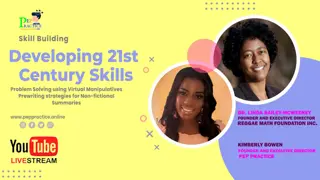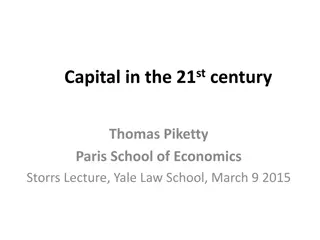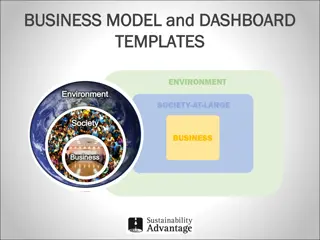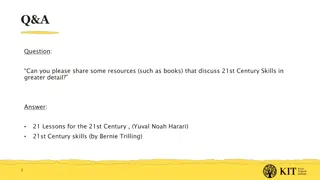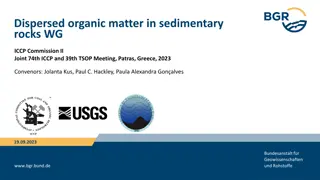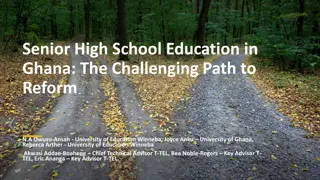21st Century Community Learning Centers Program Overview
The 21st Century Community Learning Centers (21 CCLC) program aims to support academic enrichment for students attending high-poverty, low-performing schools through a variety of enrichment opportunities and family services. The program focuses on helping students achieve academic standards, offering a safe environment during non-school hours, and engaging families in educational development. With specific goals in place, such as providing tutorial services, a broad array of activities, and promoting family engagement, the program contributes to the overall educational growth and well-being of students.
Download Presentation

Please find below an Image/Link to download the presentation.
The content on the website is provided AS IS for your information and personal use only. It may not be sold, licensed, or shared on other websites without obtaining consent from the author. Download presentation by click this link. If you encounter any issues during the download, it is possible that the publisher has removed the file from their server.
E N D
Presentation Transcript
U.S. Department of Education 21st Century Community Learning Centers (21 CCLC) federal funds. CFDA # 84.287C
Program Overview The 21st Century Community Learning Centers (21 CCLC) program supports the creation or expansion of community learning centers that provide academic enrichment opportunities for children, particularly students who attend high-poverty and low-performing schools. The program helps students meet state and local standards in core academic subjects, such as reading and math; offers students a broad array of enrichment activities that can complement regular academic programs; and offers literacy and other educational services to the families of participating children.
What is a Community Learning Center? *offers academic, artistic, and cultural enrichment opportunities to students and their families during non- school hours (before or after school) or periods when school is not in session (including holidays, weekends or summer recess). *assists students in meeting state and local academic achievement standards in core academic subjects *providing the students a variety of high-quality opportunities for academic enrichment that support student learning and development. *safe environment for students during non-school hours or periods when school is not in session.
Program Purpose As authorized under Title IV, Part B of the Elementary and Secondary Education Act, as amended by the No Child Left Behind Act of 2001, the specific purposes of the 21 CCLC program are to provide the following programmatic components: Provide opportunities for academic enrichment, including tutorial services to help students, particularly students who attend low performing schools, to meet state and local student academic achievement standards in core academic subjects, such as reading and mathematics. Offer students a broad array of additional services, programsand activities (such as youth development activities, drug and violence prevention programs, counseling programs, art, music, recreation, technology education programs and character education programs) that are designed to reinforce and complement the regular academic program of participating students. Offer opportunities for literacy and related educational development to families of participating students.
WY 21CCLC Goals Goal 1: To establish community learning centers that help students in high-poverty, low-performing schools meet academic achievement standards. Goal 2: To offer a broad array of high-quality enrichment activities that are aligned with and complement the regular academic school day while positively affecting student outcomes such as school attendance, academic performance, behaviors and associated risk factors. Goal 3: To provide programming to engage families of 21st CCLC participants for the purpose of increasing parent/family engagement in learning and developing resiliency through positive home/school relationships.
High Quality Programming Supportive Social Environment-Safe, engaging environments that motivate and inspire learning outside the regular school day. Relationships with students and their families Academic Learning and Skill Building-Combination of academic, enrichment, cultural, and recreational activities. Program Organization and Structures Designed for Effectiveness Direct link with regular school day personnel and learning opportunities. Professional development of staff with outcomes in mind Consistent and dependable hours of operation. Ongoing Continuous Improvement Processes across the program spectrum Promote Autonomy and Responsibility of Youth Community partnerships Strategies for retention and attendance Program focused on engagement and participation .
21st CCLC and Community- based Organizations 1. What do you need to know to start? 2. How should I think about the 21st CCLC grant considering I am an established organization? 3. Where are the sand pits, trap doors, and waterfalls in the application for CBO s?
Collaboration Requirement Each non-LEA applicant must actively collaborate with the LEAs and school(s) from which participating students attend to develop and implement the proposed program. Evidence of the collaboration must be illustrated through meeting documentation that includes references to shared vision building, planned results or outcomes, mutually identified goals, intervention strategies, and activities.
Serving Eligible Districts/Schools To meet high poverty requirement in the statute, each school served must be at or above 25% F&R lunch. To obtain Absolute Priority points- 51% of all centers/schools served must be schoolwide Title I or 40% eligible for F&R lunch. (10pts). Schools In Need of Improvement Sec 1116 (5pts).
Application Sections Contact Information (2 pts)-pg 23 Applicant Information & Competitive Priorities(12 pts)-pg 24 Capacity (9 pts)-pg 25 Populations & Needs Assessment (15 pts)-pg 26 Center Information (6 pts)-pg 26 Typical Program Operations (25 pts)-pg 27 Program Objectives/Strategies/Action Plans (30pts)-pg 28
Application Sections continued Program Abstract (12 pts)-pg 28 Timeline (10 pts)-pg 29 Professional Development (12 pts)- pg 29 Continuous Improvement and Evaluation (25 pts)- pg 29 Partnerships (15 pts)-pg 29 Sustainability (6 pts)-pg 29 Program Budget (5 pts) and Budget Narrative (25 pts)-pg 30
Allowable Activities Activities must take place during non-school hours (before or after-school) or periods when school is not in session (holidays, weekends or summer recess). Grantees are limited to providing activities within the following list and are encouraged to implement a combination of these activities to ensure a comprehensive, quality program: Highest priority: Academically-aligned programs Remedial education activities and academic enrichment learning programs, including providing additional assistance to students to allow the students to improve their academic achievement; Science, technology, engineering and mathematics education activities; Additional options: Arts and music education activities; Entrepreneurial education programs; Tutoring services and mentoring programs; Programs that provide after-school activities for limited English proficient students that emphasize language skills and academic achievement; Recreational activities; Telecommunications and technology education programs; Programs that promote parental involvement and family literacy; Programs that provide assistance to students who have been truant, suspended, or expelled, to allow the students to improve their academic achievement; Drug and violence prevention programs; Counseling programs; Character education programs: and Expanded library service hours;
Writing Objectives-SMART Your grant application will have objectives written to address broad 21CCLC goals and the needs of the students. The strategies and action steps define the work. Look at previous year s results, defined needs and the goals in order to plan your objectives for what you would like to accomplish in the initial year of the grant. You will indicate the status of your objectives at the end of each year and rewrite old or write new objectives each year. The Difference between goals and objectives: Goals are broad; objectives are more narrow and specific. Goals are general intentions; objectives are precise and measurable. Goals are abstract; objectives are concrete and attainable. Goals are intangible; objectives are tangible and relevant. Goals can't be validated as is; objectives can be validated in a timely way.
SMART Objectives What is a SMART objective? Developing objectives requires time, orderly thinking and a clear picture of the results expected from program activities. Well written objectives can be developed using the Specific, Measurable, Achievable, Relevant and Time-bound (SMART) approach. There is no single correct way to write a SMART objective. The real test is to compare the objective statement to the SMART criteria. Asking the following questions can help determine if an objective reflects the SMART criteria?
SMART Objectives continued Goal of 21CCLC Grants-Improve the academic achievement of students that regularly attend 21CCLC programs Typical Objective Increase MAP math achievement scores for regular 21CCLC attendees. SMART Objectives The percentage of regular attendees who meet or exceed their MAP math expected growth will increase 10% by the end of the school year. By the end of the 2012/2013 school year, 70% of all regularly attending 21st CCLC students in K-3rd grade will demonstrate benchmark reading skills as measured on the DIBELS assessment.
Scientifically-Based Research The authorizing statute provides principles of effectiveness (see page 11) to guide applicants in successfully identifying and implementing programs and activities that can directly enhance student learning, one of which includes activities based on scientific research. As defined in Title IX of ESEA, scientifically- based research:
SBR continued Employs systematic, empirical methods that draw on observation and experiment; Involves rigorous data analyses that are adequate to test the stated hypotheses and justify the general conclusions drawn; Relies on measurements or observational methods that provide reliable and valid data across evaluators and observers, across multiple measurements and observations, and across studies by the same or different investigators;
SBR continued Is evaluated using experimental or quasi-experimental designs in which individuals, entities, programs, or activities are assigned to different conditions and with appropriate controls to evaluate the effects of the condition of interest, with a preference for random- assignment, experiments, or other designs to the extent that those designs contain within-condition or across- condition controls; Ensures that experimental studies are presented in sufficient detail and clarity to allow for replication or, at a minimum, offer the opportunity to build systematically on the findings; and Has been accepted by a peer-reviewed journal or approved by a panel of independent experts.
Alignment-Program Activities The academic program must be aligned to the respective schools curricula, and must help students meet the recently adopted Wyoming State Standards- Common Core as well as local academic focus points in the core academic subjects. They must complement and enhance the academic performance, achievement, and positive youth development of the students.
Alignment-Budget All expenditures must be linked to the stated objectives, strategies (what), and action plan (how) in the proposal. Alignment allows for greater clarity when communicating with staff and constituents. Less confusion about which activities (and students) the grant is funding.
Applicant Organizations with Multiple Funding Streams Creating a clear 21st CCLC program takes intentional effort within a large, multi-faceted, established organization. 21st CCLC program is distinct How do the purposes and goals of 21st CCLC fit within the organization s overall strategic plan? Can specific, new, unique 21st CCLC activities be defined, measured, evaluated, and subjected to a plan for continuous improvement? Budget aligned to 21st CCLC program operations
OMB Basic Guidelines OMB=Office of Management and Budget Cost principles found in the OMB Circulars, soon to be Super Circular Reasonable and Necessary Allocable Supplement vs Supplant
Necessary and Reasonable Must be necessary for the performance or administration of the grant Must follow sound business practices: Arms length bargaining (hint: procurement processes) Follow federal, state and local laws Fair market prices Act with prudence under the circumstances No significant deviation from established prices
Practical aspects of necessary Do I really need this? Surplus property/existing resources Lease vs. purchase Is this the minimum amount I need to spend to meet my need? Practical aspects of reasonable Is the expense targeted to valid programmatic/administrative considerations? Do I have the capacity to use what I am purchasing? Did I pay a fair rate? Can I prove it? If I were asked to defend this purchase, would I be comfortable?
Allocable Can only charge in proportion to the value received by the program Example: LEA purchases a computer to use 50% in the 21stCCLC program and 50% in State program can only charge half the cost to 21stCCLC.
Auditors presume supplanting in two situations 1. Required to be made available under other federal, state, or local laws 2. Provided with non-federal funds in prior year
Applicant vs Contractor Subgrantee Determines who is eligible to participate in a federal program Has its performance measured against whether the objectives of the federal program are met Is responsible for programmatic decision making Is responsible for complying with federal program requirements Uses the federal funds to carry out a program as compared to providing goods or services for a program
Applicant vs Contractor Contractor Provides the goods and services within normal business operations Provides similar goods or services to many different purchasers Operates in a competitive environment Provides goods or services that are ancillary to the operation of the federal program Is not subject to compliance requirements of the federal program
Positive Youth Development Positive youth development refers to a philosophy and approach to working with young people that recognizes that: multiple domains of young people s development (i.e., cognitive, social, emotional, physical, and moral) are interconnected; all young people have strengths and prior knowledge that serve as a platform for subsequent development; and young people are active agents of their own growth and development.
Getting Started Make a calendar with deadlines Draft all narratives in Word to cut and paste into GMS Begin with goals/objectives Work closely with business managers and payroll if you are unfamiliar with budgeting Remember that the application is a legal document; be realistic. Always keep the rubric handy. Decide which priority points are within the scope of your proposed program. Create an application on GMS
Cohort 9 GMS Application Walk Through Overview and Contact Information Award Process Applicant Information and Capacity Program Details-7 Sub-tabs Populations and Needs Assessment, Center Info, Typical Operations, Goals/Objectives/Strategies/ Action Plan, Abstract, Partnerships, Sustainability Budget Assurances
Current Wyoming 21 CCLC Program Locations Albany County SD #1- Greater Wyoming Big Brothers Big Sisters Big Horn County SD #2-Big Horn County Health Coalition Campbell County SD #1-Campbell County 21CCLC Project Uinta County BOCES Carbon County SD #1-Boys and Girls Club of Carbon County Carbon County SD #2-Greater Wyoming Big Brothers Big Sisters- Saratoga Converse County SD #1 Fremont County SD #1- Lights On In Lander Fremont County SD #2 Fremont County SD #6 Goshen County SD #1-The PRACTICE Program Hot Springs County SD #1 Laramie County SD #1-Laramie County Community Partnership Natrona County SD #1-Natron County Prevention Coalition Park County SD #1 and Park County SD #6-Boys and Girls Club of Park County Platte County SD #1-Platte County Prevention Coalition (ending March) Sweetwater SD #1 Teton County #1 Washakie County SD #1 Weston County SD #1
Discussion and Questions How much should a program cost per participant/regular? Do we really need a coordinator? Can we buy _______? What s an MOU? Who decides whether or not the priority points are to be awarded? The recorded version will be available at www.wenvideo.net
Karen Bierhaus 21st CCLC Program Consultant Wyoming Department of Education 320 West Main St. Riverton, WY 82501 307-857-9284 karen.bierhaus@wyo.gov
